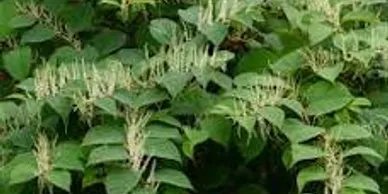Japanese Knotweed--Reynoutria japonica
.
Description
Japanese knotweed is a perennial herb that grows up to 10-feet tall and forms dense stands that resemble bamboo. It was brought from eastern Asia as an ornamental garden plant and was also used for erosion control. It has heart-shaped leaves and white flowers. Its stems are hollow, and young shoots are often covered in red speckles. Knotweed produces small, winged fruits that contain shiny, triangular seeds. The dead stems of Japanese knotweed typically remain standing in winter.
Problem
Knotweed forms dense stands that displace native vegetation. Reproduction occurs both by rhizomes (laterally growing roots) and seeds, making this plant extremely hard to eradicate. Knotweed rhizome fragments (a rhizome is a continuously growing, horizontal underground stem that puts out lateral shoots) often grow in areas of recent soil disturbance. Rhizomes may spread 50 feet or more laterally and may penetrate many feet deep into the soil. It often invades riparian (riverside) habitats as rhizomes are scoured from stream banks and carried downstream. Although this species commonly invades disturbed areas with high light, such as roadsides, stream banks and shorelines, it can also grow in full shade conditions because of its high tolerance for drought, temperature, and salinity.
Management
Because knotweed can regrow full plants from its cuttings as well as from its rhizomes, knotweed cannot be hand pulled or cut down, but must be dug up to eradicate the entire root structure, and then disposed of off-site. Herbicides can be successful but require repeated applications, either as a foliar spray or by application to freshly cut stems in late summer and early fall. Stem injection of herbicides has been highly successful in some instances but requires specialized equipment and is extremely time- and labor-intensive. Always read and follow the directions on the label when using herbicide. In wetlands, use only herbicides registered for those areas.
In Newburyport’s yard waste center, any cuttings should be contained in a brown paper leaf bag with a closed top and placed in the designated location per the attendant or cuttings may disperse and reestablish. You may also call the Sustainability Office at 978/499-0413 to get advice on the best disposal options for invasive plant cuttings.

